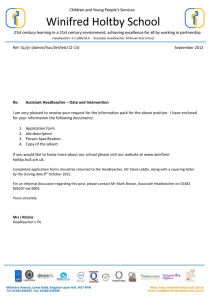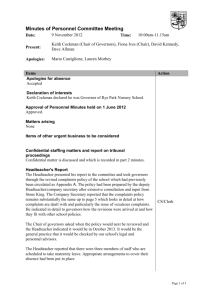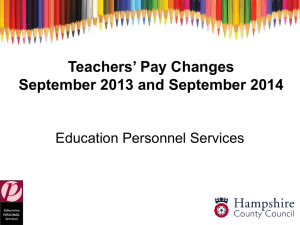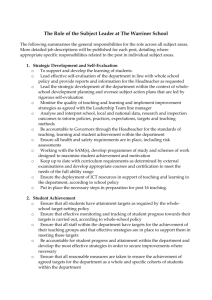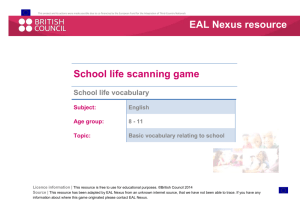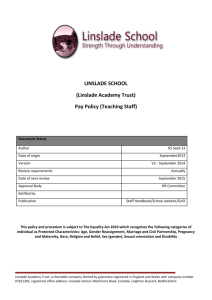Teachers` Pay & Performance guidance for Governors Jan 2014
advertisement
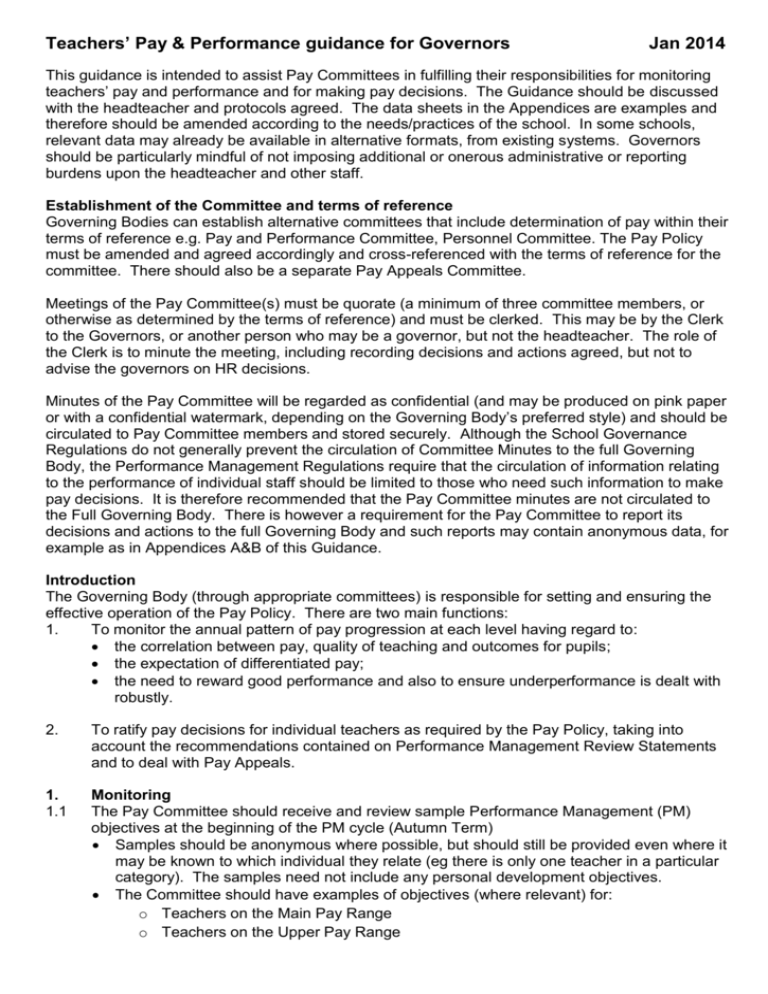
Teachers’ Pay & Performance guidance for Governors Jan 2014 This guidance is intended to assist Pay Committees in fulfilling their responsibilities for monitoring teachers’ pay and performance and for making pay decisions. The Guidance should be discussed with the headteacher and protocols agreed. The data sheets in the Appendices are examples and therefore should be amended according to the needs/practices of the school. In some schools, relevant data may already be available in alternative formats, from existing systems. Governors should be particularly mindful of not imposing additional or onerous administrative or reporting burdens upon the headteacher and other staff. Establishment of the Committee and terms of reference Governing Bodies can establish alternative committees that include determination of pay within their terms of reference e.g. Pay and Performance Committee, Personnel Committee. The Pay Policy must be amended and agreed accordingly and cross-referenced with the terms of reference for the committee. There should also be a separate Pay Appeals Committee. Meetings of the Pay Committee(s) must be quorate (a minimum of three committee members, or otherwise as determined by the terms of reference) and must be clerked. This may be by the Clerk to the Governors, or another person who may be a governor, but not the headteacher. The role of the Clerk is to minute the meeting, including recording decisions and actions agreed, but not to advise the governors on HR decisions. Minutes of the Pay Committee will be regarded as confidential (and may be produced on pink paper or with a confidential watermark, depending on the Governing Body’s preferred style) and should be circulated to Pay Committee members and stored securely. Although the School Governance Regulations do not generally prevent the circulation of Committee Minutes to the full Governing Body, the Performance Management Regulations require that the circulation of information relating to the performance of individual staff should be limited to those who need such information to make pay decisions. It is therefore recommended that the Pay Committee minutes are not circulated to the Full Governing Body. There is however a requirement for the Pay Committee to report its decisions and actions to the full Governing Body and such reports may contain anonymous data, for example as in Appendices A&B of this Guidance. Introduction The Governing Body (through appropriate committees) is responsible for setting and ensuring the effective operation of the Pay Policy. There are two main functions: 1. To monitor the annual pattern of pay progression at each level having regard to: the correlation between pay, quality of teaching and outcomes for pupils; the expectation of differentiated pay; the need to reward good performance and also to ensure underperformance is dealt with robustly. 2. To ratify pay decisions for individual teachers as required by the Pay Policy, taking into account the recommendations contained on Performance Management Review Statements and to deal with Pay Appeals. 1. 1.1 Monitoring The Pay Committee should receive and review sample Performance Management (PM) objectives at the beginning of the PM cycle (Autumn Term) Samples should be anonymous where possible, but should still be provided even where it may be known to which individual they relate (eg there is only one teacher in a particular category). The samples need not include any personal development objectives. The Committee should have examples of objectives (where relevant) for: o Teachers on the Main Pay Range o Teachers on the Upper Pay Range o Teachers on the Leadership Scale o Leading Practitioners The Committee may seek, where possible, to have examples of objectives for staff at the top and bottom of the main and upper pay ranges 1.1.1 The Pay Committee should satisfy themselves that the objectives: are sufficiently differentiated between the different pay ranges and where appropriate within pay ranges relate to the priorities and plans of the school in terms of school improvement are SMART objectives (specific, measurable, attainable, relevant, time-bound) and that there are clear success criteria. 1.1.2 It is not for the Pay Committee to set or revise objectives. Where there are concerns that the elements of 1.1.1 are not satisfied, the Pay Committee should discuss these concerns with the headteacher. Any revisions to PM objectives should be made by the PM Reviewer in discussion with the employee. 1.2 Mid-year monitoring The Pay Committee should receive, mid-year, information about the overall performance of all teachers. The overall performance of teachers includes: Progress against objectives Performance against the teaching standards (including eg classroom observations) Performance in the job role Personal responsibility for Continuous Professional Development (CPD) 1.2.1 The information the Committee receives at this stage need not be very detailed, but should give an indication, by pay level, of whether teachers are on track to meet overall performance expectations or are above or below this level. See Appendix A for sample format. The information should again be anonymous (where possible) and should be an indication of the progress of teachers at different levels. 1.2.2 The information should be examined and compared to information about the overall quality of teaching and pupil progress/attainment. Any disparity should be discussed with the headteacher. Any revisions to PM objectives should be made by the PM Reviewer in discussion with the employee. 1.3 End of year monitoring 1.3.1 The Pay Committee has a role in ratifying/making pay decisions at the end of each year for individual teachers and this is dealt with in Section 2. Alongside looking at individual decisions, the Pay Committee has a responsibility to monitor the overall picture of performance and pay progression each year to ensure consistency of pay decisions between teachers, and between pay decisions and overall school performance. It is recommended that the Pay Committee review the overall picture prior to making individual pay decisions. This moderation allows the Committee to challenge any inconsistencies between the data and affords the headteacher the opportunity to review any pay recommendations, prior to consideration by the Pay Committee. 1.3.2 The Pay Committee should receive, at the end of the PM year, information about the overall performance of all teachers (as set out in 1.2 above) and any pay recommendations. See Appendix B for example format. The information should again be anonymous (where possible) and should be an indication of the progress of teachers at different levels. 1.3.3 The information should be examined and compared to information about the overall quality of teaching and pupil progress/attainment and any disparity discussed with the headteacher. 2 2.1 Pay Decisions The Pay Policy will determine who has responsibility for making pay decisions. In some cases this may be the headteacher (who will then simply report decisions to the Pay Committee) and in others, the Pay Committee will make/ratify decisions, based on recommendations from the headteacher or performance management reviewer(s). 2.1.1 All Performance Management Review Statements should, where applicable, contain a recommendation on Pay Progression. Where the teacher disagrees with the recommendation this should have been discussed at the Review meeting and should be recorded on the Statement. The Pay Committee should receive a copy of the teachers’ PM Review Statement where they are required to make/ratify a pay decision in respect of that individual. It is recommended that Committee members consider this statement at the meeting, but do not retain a copy of the review statement. 2.1.2 The Pay Committee should already have been satisfied, through their monitoring activities set out in Section 1, that the PM process is robust, fair and consistent. It is not the role of the Pay Committee to assess the performance of individual teachers. It is the Committee’s role to ensure that a proper and fair process has been followed in respect of the individual teacher and that all relevant information has been taken into account in assessing their performance and making a pay recommendation. 2.1.3 Governors should refer to their own Pay Policy. In the Essex Education HR Model Policy (Sept 2013) the criteria for Performance Pay Progression are as set out at Appendix C. 2.2 Progression to the Upper Pay Range As set out in their Pay Policy, the Pay Committee may be responsible for approving applications to progress to the Upper Pay Range. 2.2.1 Governors should refer to their own Pay Policy. In the Essex Education HR Model Policy (Sept 2013) the criteria for Progression to the Upper Pay Range are as set out at Appendix C. 2.3 Determination of Headteacher’s Pay The Headteacher’s Performance Review Panel will assess the headteacher’s overall performance and make a recommendation on pay progression to the Pay Committee. The Pay Committee will make a decision on pay progression accordingly and will also decide any additional allowances for the headteacher, where applicable, in accordance with the Teachers’ Pay and Conditions Document. The criteria for leadership pay progression are as set out in Appendix C. 2.4 Other pay decisions The Pay Committee may have responsibility, as set out in their Pay Policy for approving other pay related decisions e.g. the award of Recruitment & Retention benefits and/or the allocation of TLRs. The Committee should ensure that such decisions are made in line with the terms of their Pay Policy and the Teachers’ Pay & Conditions Document, and that such decisions are made in a fair and consistent manner. 3. Pay Appeals 1.1.2 Any appeals should be heard by the Pay Appeals Committee. The role of the Appeal’s Committee, as the Pay Committee is to examine whether a proper and fair process has been followed and that all relevant information has been taken into account in reaching the Pay Decision. It is not the role of the Appeals Committee to assess the individual teacher’s performance. Performance Against Teaching Standards No. meeting Outstanding Classroom observation assessments Good No. below expectations No. of staff in group No. above expectations Pay Level No. on track Performance against objectives Requires improvement Appendix A – Sample Format - Mid Year Teacher Performance Report for the Pay Committee Meeting job role CPD Comments No. on track Main Pay Range MPR + TLR Upper Pay Range UPR + TLR Leadership Scale Leading Practitioner The Pay Committee should cross check this to ensure correlation between the elements and should consider this data alongside data on pupil progress/attainment and discuss any disparity with the headteacher. Appendix B – Sample Format – End of Year Teacher Performance Report for the Pay Committee No. not met Performance Against Teaching Standards No Met Outstanding Good Classroom observation assessments Requires improvement No. in group No. of staff who did not meet Pay Level No. of staff who Met Performance against objectives Meeting job role CPD No. Met Pay Progression Recommended No. Approved Comments Main Pay Range MPR + TLR Upper Pay Range UPR + TLR Leadership Scale Leading Practitioner Year 1/7 Year 2/8 Year 3/9 Year 4/10 Year 5/11 Year 6/12 The Pay Committee should cross check this to ensure correlation between the elements and should consider this data alongside data on pupil progress/attainment and discuss any disparity with the headteacher. Appendix C – Performance Pay Progression Criteria Teachers “A teacher will be eligible for annual performance pay progression where they: 1) have been assessed as meeting all of the teaching standards, throughout the assessment period; 2) have had their teaching assessed as at least good overall during the assessment period; 2a) Upper Pay Range teachers will be expected to demonstrate increasing levels of outstanding teaching overall 2b) Leading Practitioners will be expected to demonstrate outstanding teaching overall 3) have been assessed as meeting the requirements of their job description/job role; 4) meet their individual performance management objectives; Consideration will be given where factors beyond the teacher’s control have impacted on their ability to meet objectives; 5) have demonstrated a personal responsibility for identifying and meeting their CPD needs. The evidence which will be considered in assessing performance will include: pupil progress data; quality of teaching against the Teaching Standards, including observed practice; self-assessment; professional dialogue; received feedback; performance management statements; CPD records. And in the case of Upper Pay Range teacher and Lead Practitioners, evidence of their contribution beyond their own classroom and their impact on the wider school. Where a teacher has been absent for some or all of the assessment period, an assessment will be based on performance during any periods of attendance and/or prior performance.” (Essex Education HR Model Pay Policy Sept 2013) Leadership In addition to any assessment related to teaching, the performance criteria for those on the leadership scale are that: they have demonstrated sustained high quality performance; the individual has grown professionally by developing their leadership expertise. (Teachers’ Pay & Conditions Document) Progression to the Upper Pay Range An application will be successful, if the Headteacher and the Pay Committee are satisfied that: the teacher is highly competent in all elements of the teaching standards; and, the teacher’s achievements and contribution to the school are substantial and sustained. In this school, this means that the teacher has consistently demonstrated that they meet all teaching standards, both in terms of teaching and personal and professional conduct, over a sustained period: been assessed as meeting their performance management objectives over a sustained period; and in addition that; teaching has been rated as good overall, with some outstanding, over a sustained period; the teacher has demonstrated over a sustained period an ability to support some pupils to exceed expected levels of progress/achievement; the teacher has consistently taken responsibility for identifying and meeting their own professional development needs and used their learning to improve their own practice and pupils’ learning; the teacher has demonstrated that they have made an impact on the school beyond their own class/group(s) over a sustained period. This may include o demonstrating an ability to coach, mentor, advise and demonstrate best practice to, other teachers to enable them to improve their teaching practice; o contributing to policy and practice which has improved teaching and learning across the school; Sustained means maintained continuously over a period of at least 3 school years (a year being defined as at least 26 weeks work in any academic year). It is normally expected that this will include at least one year at this school, although discretion will be exercised where there is clear and compelling evidence of consistent performance against the criteria at the teacher’s previous school. Only 2 years’ worth of evidence will be required from teachers who are on the equivalent of old points M4, M5 or M6 on 1 September 2013, so that they are not disadvantaged in comparison to the previous Threshold criteria. The school will exercise its discretion to consider performance over a lesser period where a teacher has been absent for some of the relevant period. (Essex Education HR Model Pay Policy Sept 2013) Appendix D – glossary CPD – Continuous Professional Development HR – Human Resources LS – Leadership Scale LP – Leading Practitioners M – Mainscale (old range) MPR – Main Pay Range PM – Performance Management PMR – Performance Management Review TPCD – School Teachers’ Pay and Conditions Document TLR – Teaching and Learning Responsibility award UPR – Upper Pay Range
